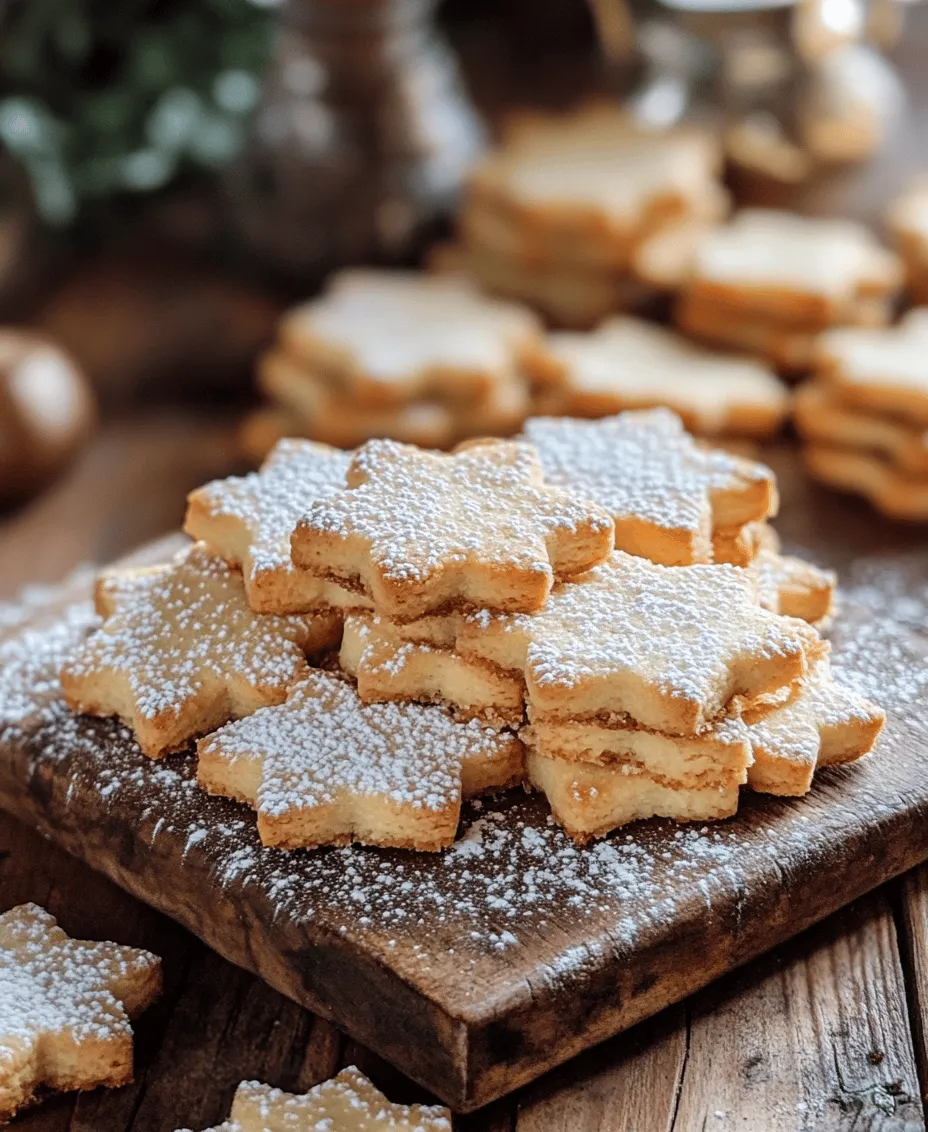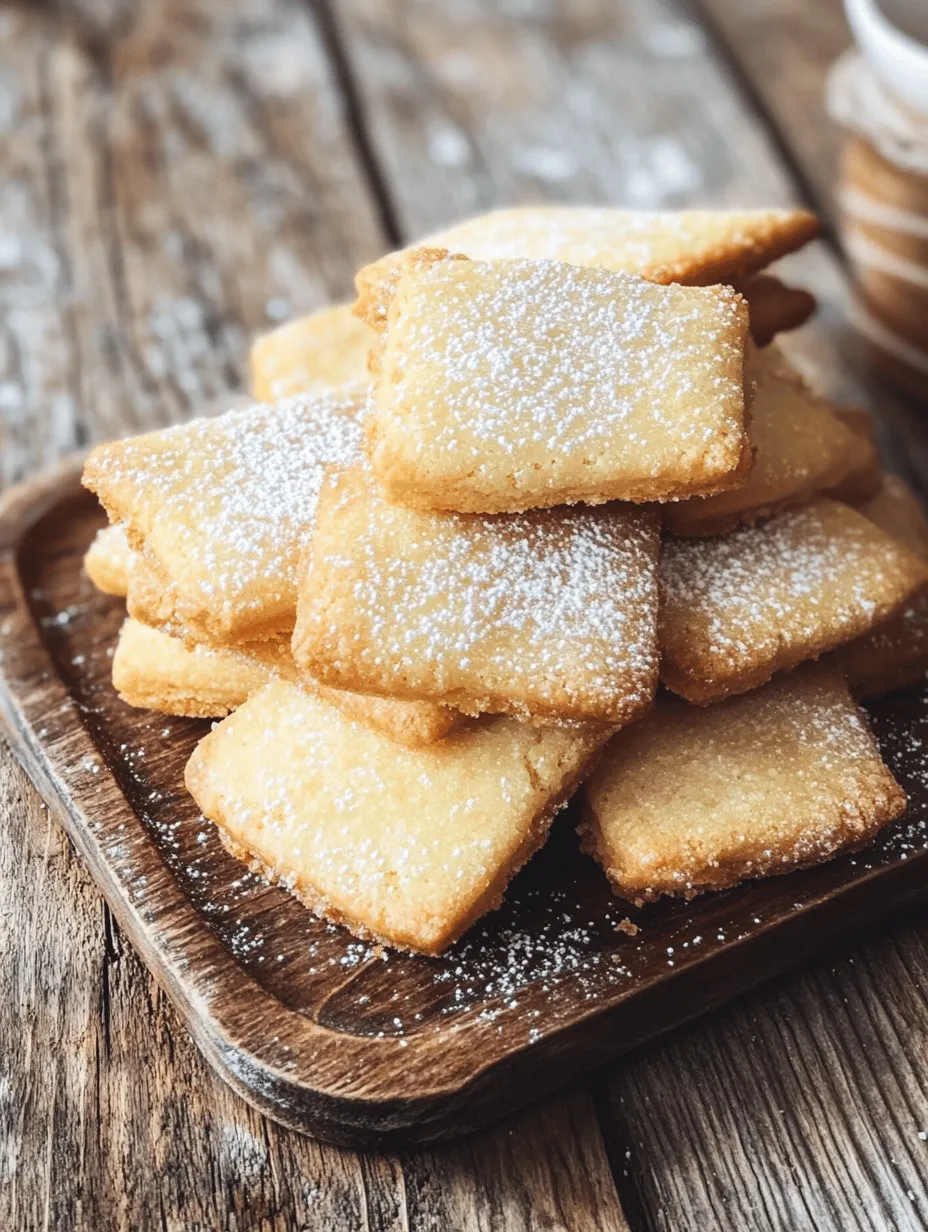Introduction: The Charm of French Butter Cookies
When it comes to the world of desserts, few treats evoke as much charm and sophistication as French butter cookies. These delightful morsels are renowned for their buttery richness and melt-in-your-mouth texture, making them an essential addition to any cookie lover’s repertoire. The allure of French butter cookies lies not just in their exquisite taste, but also in their simple yet elegant flavor profile that captures the essence of French baking traditions. Whether enjoyed alongside a steaming cup of tea, presented as an elegant gift to friends and family, or savored as a personal indulgence, these cookies are a timeless classic that never fails to impress.
French butter cookies, known as “Sablés,” have a deep-seated history in French cuisine, steeped in the traditions of pastry-making that have been passed down through generations. Their name, which translates to “sand” in French, reflects their crumbly texture that is achieved through the perfect balance of ingredients, particularly butter. As we delve into the world of French butter cookies, you’ll discover not just how to make them, but also the rich heritage that makes these cookies a beloved treat across the globe.
The Allure of French Butter Cookies
Understanding the Origin of French Butter Cookies
The origin of French butter cookies dates back to the 17th century, a time when French bakers began to experiment with rich ingredients like butter, sugar, and flour. The result was a range of cookies that showcased the quality of French dairy and the artistry of its bakers. Traditionally, these cookies were made in various shapes and sizes, often enhanced with different flavors, such as citrus zest or chocolate. Their versatility made them a favorite among families and royal courts alike, allowing them to be enjoyed at both casual gatherings and lavish feasts.
As you explore this recipe for French butter cookies, you’ll appreciate the meticulous attention to detail that defines French baking. Each ingredient plays a crucial role in creating the perfect texture and flavor, transforming simple components into a sophisticated treat that embodies the essence of French culinary artistry.
The Role of Butter in French Pastry
Butter is arguably the star ingredient in French butter cookies, and for good reason. The quality and type of butter used can significantly impact the flavor and texture of the final product. French butter, known for its higher fat content and creamier consistency compared to standard butter, lends a luxurious richness to the cookies. This fat is essential for achieving that signature melt-in-the-mouth experience that makes these cookies so delightful.
In addition to flavor, butter also contributes to the structure of the cookie. When creamed with sugar, it creates air pockets that expand during baking, leading to a light and tender texture. The temperature of the butter—room temperature versus chilled—also plays a critical role in the mixing process, affecting the overall consistency of the dough. As you embark on this baking journey, remember that using high-quality butter will ultimately elevate your French butter cookies to new heights.
Comparing French Butter Cookies to Other Cookie Varieties
While there are countless cookie varieties around the world, French butter cookies stand out for their unique texture and rich flavor profile. Unlike American-style cookies, which tend to be thicker and chewier due to the use of brown sugar and baking soda, French butter cookies are typically crisp and crumbly. This difference is primarily due to the higher butter content and the absence of leavening agents in many traditional recipes.
Other cookies, such as sugar cookies or oatmeal cookies, often focus on sweetness and texture that cater to different taste preferences. In contrast, French butter cookies allow the flavor of the butter to shine through, making them a more refined choice for those who appreciate the subtleties of pastry. Moreover, these cookies can be easily adapted with various flavorings, making them a versatile option for any occasion.
Ingredients: The Heart of the Recipe
To create the perfect batch of French butter cookies, you’ll need to gather a few essential ingredients that work in harmony to produce that decadent flavor and texture. Here’s what you’ll need:
Essential Ingredients for French Butter Cookies
– Unsalted Butter: The Foundation of Flavor
Unsalted butter is the cornerstone of any good French butter cookie recipe. It provides the rich, creamy flavor that these cookies are known for. Using unsalted butter allows you to control the salt content in your recipe, ensuring a balanced taste.
– Granulated Sugar and Powdered Sugar: Sweetness Levels
Both granulated sugar and powdered sugar are used in this recipe to create the perfect sweetness and texture. Granulated sugar contributes to the cookie’s structure, while powdered sugar helps to achieve a delicate crumb and adds a touch of sweetness without being overpowering.
– Salt and Vanilla Extract: Enhancing Natural Flavors
A pinch of salt is essential in balancing the sweetness and enhancing the overall flavor of the cookies. Vanilla extract adds a warm, aromatic note that complements the rich butter flavor, making each bite even more irresistible.
– Flour Varieties: All-Purpose Flour vs. Almond Flour
The primary flour used in French butter cookies is all-purpose flour, which provides the necessary structure. However, some variations incorporate almond flour for a nutty flavor and a slightly different texture. This can be a delightful alternative for those looking to experiment with flavors or cater to gluten-free diets.
– Baking Powder: The Secret to Perfect Texture
A small amount of baking powder can be added to create a lighter texture, though many traditional recipes do not call for it. The choice to include baking powder depends on the desired outcome, and you can experiment to find what works best for your taste.
Preparation: Crafting the Perfect Dough
Once you have gathered your ingredients, it’s time to prepare your workspace and start crafting the perfect dough for your French butter cookies.
Setting Up Your Workspace: Tools and Equipment
Before diving into the mixing process, it’s important to set up your workspace with the right tools and equipment. Here’s what you’ll need:
– Mixing Bowls: Use a large mixing bowl for combining the butter and sugars, and a smaller bowl for measuring out your dry ingredients.
– Electric Mixer or Whisk: An electric mixer will make creaming the butter and sugar effortless, but a whisk can also do the trick if you prefer a more hands-on approach.
– Spatula: A rubber spatula is ideal for folding in dry ingredients and scraping down the sides of your mixing bowl.
– Baking Sheets: Line your baking sheets with parchment paper or silicone mats to prevent sticking and ensure even baking.
Importance of Room Temperature Butter
One of the critical aspects of making French butter cookies is ensuring that your butter is at room temperature. This means that the butter should be soft enough to leave an indentation when pressed but not melted. Room temperature butter cream more easily with sugars, creating a light and airy texture that is essential for the cookies’ structure. If you forget to take your butter out ahead of time, you can cut it into small cubes and let it sit at room temperature for about 15-20 minutes to soften.
Step-by-Step Guide to Making French Butter Cookies
Now that your workspace is set up and you have all your ingredients ready, let’s walk through the step-by-step process of making French butter cookies.
1. Preheating the Oven: Why Temperature Matters
Preheat your oven to 350°F (175°C). Preheating is crucial because it ensures that your cookies bake evenly and develop that perfect golden-brown color. While the oven heats, you can start preparing your dough.
2. Creaming the Butter and Sugars
In a large mixing bowl, add your room temperature unsalted butter and both the granulated and powdered sugars. Using your electric mixer or whisk, cream the butter and sugars together until the mixture is light and fluffy. This process typically takes about 2-3 minutes with an electric mixer.
3. Incorporating Flavorings
Once the butter and sugars are well combined, add a pinch of salt and a splash of vanilla extract. Mix until evenly incorporated. The aroma of vanilla will start to fill your kitchen, setting the stage for the delightful cookies to come.
4. Adding the Dry Ingredients
In a separate bowl, whisk together the all-purpose flour and baking powder (if using). Gradually add this dry mixture to the wet ingredients, mixing just until combined. Be careful not to overmix, as this can lead to tough cookies. The dough should come together nicely, with a cohesive yet slightly crumbly texture.
5. Chilling the Dough (Optional)
For best results, consider chilling the dough for about 30 minutes. Chilling allows the butter to firm up, which helps the cookies maintain their shape during baking. If you’re short on time, you can skip this step, but be aware that the cookies may spread more during baking.
With these initial steps completed, you’re well on your way to crafting a batch of delightful French butter cookies that will impress anyone lucky enough to taste them. Stay tuned for the next part of this article, where we will explore shaping, baking, and the finishing touches that make these cookies truly special.

Creaming Technique: Achieving the Right Consistency
To begin crafting your delightful French butter cookies, mastering the creaming technique is essential. This process involves blending softened butter and sugar until the mixture is light and fluffy, which is critical for ensuring that your cookies have a soft, tender crumb. Start by placing the softened unsalted butter in a large mixing bowl. Using an electric mixer on medium speed, beat the butter for about 1-2 minutes until it becomes smooth and creamy.
Next, gradually add the granulated sugar while continuing to mix. Aim for a light and airy consistency; this will take an additional 2-3 minutes. You want to aerate the butter to create tiny pockets of air, which will help your cookies rise beautifully in the oven. Scrape down the sides of the bowl periodically to ensure all ingredients are well incorporated. The final mixture should be pale in color and should hold a light, fluffy texture.
Incorporating Dry Ingredients: Tips for a Smooth Dough
Once you have achieved the perfect creamed mixture, it’s time to fold in the dry ingredients. Sift together all-purpose flour, cornstarch, and a pinch of salt in a separate bowl. Sifting not only removes lumps but also aerates the flour, ensuring a lighter cookie. Gradually add the dry mixture into the creamed butter and sugar, mixing gently on low speed or using a spatula to combine.
Be careful not to overmix at this stage, as this can lead to tough cookies. Mix just until the dry ingredients are incorporated and the dough comes together. If desired, you can add a splash of pure vanilla extract at this point for added flavor. The result should be a smooth dough that is slightly sticky but holds together well.
Shaping and Flattening: Techniques for Uniform Cookies
With your dough ready, it’s time to shape the cookies. Start by dividing the dough into equal portions, typically about 1 tablespoon each. Roll each portion into a ball and place them on a parchment-lined baking sheet. For a classic French butter cookie look, you can flatten each ball gently with your palm, or use the bottom of a glass to achieve a uniform thickness.
For added flair, consider using a fork to create a decorative pattern on top of each cookie. This not only enhances the visual appeal but also helps create an even texture. Make sure to leave enough space between each cookie on the baking sheet, as they will spread slightly while baking.
Baking: Achieving Optimal Results
Understanding Baking Times and Temperatures
The ideal baking temperature for French butter cookies is typically around 350°F (175°C). Preheat your oven for at least 15 minutes before placing the cookies inside. This ensures even baking and helps achieve a perfect golden color.
Bake the cookies for approximately 10-12 minutes, keeping an eye on them as baking times may vary based on oven type and cookie size. To help you determine the right time, consider using a kitchen timer set for 10 minutes.
The Importance of Watching for Visual Cues
Visual cues are crucial when it comes to knowing when your cookies are done. Look for a slight golden edge around the cookies, while the centers may still appear soft. This is ideal, as they will continue to firm up as they cool on the baking sheet.
How to Know When Cookies Are Done
To test for doneness, gently press the center of a cookie with your finger. If it springs back, it’s ready to come out of the oven. If it leaves an indentation, give it another minute or two. Remember, the cookies will continue to cook on the baking sheet after being removed from the oven, so it’s better to err on the side of underbaking slightly.
Cooling and Storing French Butter Cookies
Best Practices for Cooling to Maintain Texture
After baking, transfer the cookies to a wire rack using a spatula. Allow them to cool completely; this step is essential for maintaining their delicate texture. Cooling on a wire rack allows air to circulate around the cookies, preventing them from becoming soggy.
Storing Techniques for Freshness
To keep your French butter cookies fresh, store them in an airtight container. Layer the cookies between sheets of parchment paper to prevent them from sticking together. They can be kept at room temperature for up to a week. For longer storage, consider freezing the cookies. Place them in a freezer-safe container or bag, and they can last for up to three months. Simply thaw at room temperature before serving.
Serving Suggestions: Elevating the Experience
Pairing French Butter Cookies with Beverages
Enhance your French butter cookies experience by pairing them with the perfect beverages. A classic option is a cup of freshly brewed coffee. The rich flavors of the coffee complement the buttery sweetness of the cookies beautifully. Alternatively, a fragrant cup of tea, such as Earl Grey or chamomile, can create a lovely afternoon treat.
For a more indulgent experience, serve the cookies alongside a glass of milk or a scoop of vanilla ice cream—perfect for those with a sweet tooth.
Creative Ways to Serve: Decorative Ideas
Presentation can elevate your cookie experience significantly. Consider arranging the cookies on a decorative platter, adding fresh fruit or edible flowers to enhance the visual appeal. For a rustic touch, wrap them in simple craft paper tied with twine, making them perfect for a casual gathering.
Gifting and Presentation
Ideas for Packaging Cookies as Gifts
French butter cookies make delightful gifts, especially during holidays or celebrations. Consider packaging them in a decorative tin or box, layered with parchment paper. Embellishing the package with ribbons or handwritten tags can add a personal touch that recipients will appreciate.
Personal Touches to Enhance Presentation
To give your gift a unique flair, consider including a handwritten recipe card. This not only shares the joy of baking but also invites others to create their own batch of these delightful cookies. You can also create themed gift sets, pairing your cookies with homemade jams or flavored teas for a complete experience.
Conclusion: Embracing the Joy of Baking
French butter cookies embody the essence of simple, yet sophisticated dessert-making. With their rich buttery flavor and delicate texture, they are a reminder of the joys of home baking and the satisfaction that comes from creating something special. This recipe not only offers a delicious treat but also invites you to immerse yourself in the artistry of French cuisine. Celebrate the tradition and share the love of these delightful cookies with friends and family, making every moment a little sweeter. Whether enjoyed with a warm beverage, gifted to loved ones, or simply savored on your own, these cookies are sure to bring joy to any occasion. Embrace the experience of baking and indulge in the delightful world of French butter cookies.


